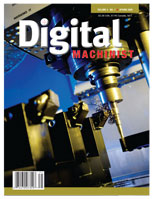by George Bulliss
After our last Digital Machinist email tip I received a number of letters requesting some clarification on the subject of programming arcs, particularly with I and J commands. While the section of the tip supplied by Tormach was plenty clear, the diagram I added left some scratching their heads. For those who may still have some questions, I offer this brief explanation. (Click the drawing to englarge it.)

The diagram assumes a clockwise direction of travel, starting with arc #1. The line immediately before arc 4 would be a straight line move (G1) to the beginning of the arc (G1 X4 Y.5). Note that the coordinates are expressed in absolute terms. In other words, they reflect the location of the beginning point of the arc in relation to the machine zeros, in this case set to the lower left corner of the part. 4 inches over in the X direction, and .5 inches up in the Y direction – both positive moves.
Now, to begin the arc we first specify G2 (clockwise) and then specify the end point of the arc in X Y absolute coordinates. In this case it is G2 X3.5 Y0. This tells the mill where to end up after cutting the arc but does not define the arc radius. To do so we can use I and J coordinates to locate the arc center, but they are relative coordinates, or the distance from a point in the tool path (the start point of the arc).
You can think of I as a measurement in the X direction and J as a measurement in the Y direction. So, from the start point of the arc, the center is located .5 over in the X negative direction and no movement in the Y would be needed to travel from the arc start point to the arc center. This is expressed as I-.5 J0. When actually writing the code, the J would not be needed since it is at zero; I only included it to help the illustration.
The last tip also brought a reply from a reader in Wisconsin, Jerry Finch. Mr. Finch taught for a number of years at Fox Valley Technical College and he was nice enough to pass along some illustrations he used to help teach G-code. The illustrations are too large to use for an email tip, but they will be in the Summer issue of Digital Machinist and I am sure they will be a big help to those starting down the CNC path.
Please do us a tremendous favor and forward this e-mail to your machining friends!
Please do us a tremendous favor and forward this e-mail on to your machining friends!
Are you not a subscriber to DIGITAL MACHINIST? Visit us at www.digitalmachinist.net and request a no-obligation issue, or call and request it at 1-800-447-7367. Tell them you received an e-mail from a friend!
And don’t forget to check out Digital Machinist’s page on Facebook and our Twitter feed!
Your friend thinks you’ll enjoy DM, or you wouldn’t have this e-mail!
We hope you enjoyed this e-mail tip, brought to you by your friends at Digital Machinist.
Get Involved!
Do you enjoy our e-mail tips? Has one of them ever “knocked something loose” in your head? Your tip could be a future e-mail blast from your favorite magazine. Just send your tips to george.bulliss@VPDemandCreation.com. If we use your tip, we will extend your subscription by an issue. We like to see 200 to 300 words, plus an image, if available. Thanks!

